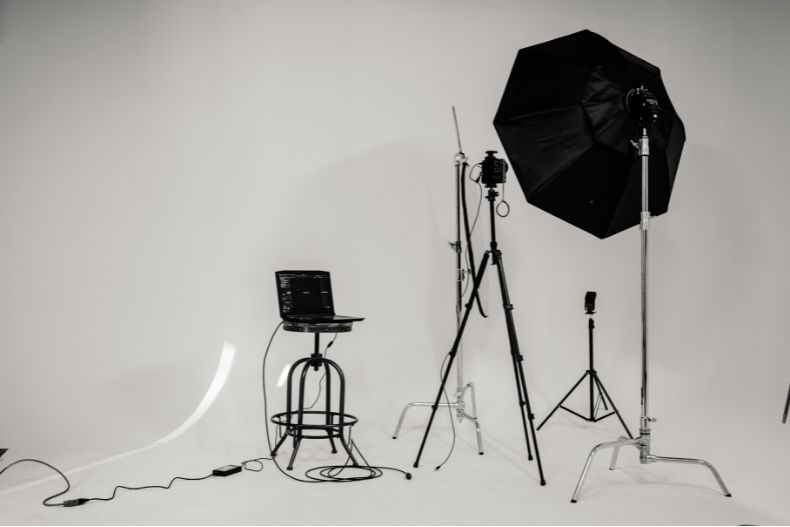How would you react if your boss told you that your office was going to get its own movie studio?
Depending on what sector you operate in, this might not be surprising. If your company is active in the media sector, for example, this would make perfect sense. But what if your company makes software, or is involved in precision engineering, or insurance, or funerals?
For most businesses, the idea of getting your own studio might seem surprising. It would be natural to ask ‘Why?’.
Well, I’m glad you asked.

Get ready for Hybrid Events
Today, there are very few cases in which a business would not benefit from having a dedicated studio. The shift to digital took a massive lurch forward in the past few years. This change is forcing a new way of working and interacting with customers.
In our new digital age, the importance of digital storytelling and video content has taken center-stage. Webinars and hybrid events have become the default option for marketing and sales initiatives. The expected standard is high, too. Companies need to provide the highest level of digital content and online experience.
As our expectations have progressed, so has the technology. Today, there are amazing possibilities for businesses to create their own studio with the same technologies used by big-budget movie studios. These solutions come with a business-friendly combination of reasonable cost and ease of use.
The result is a high utilization rate and a rapid ROI.
Different types of studio for businesses
For business, the best studio technology is the ‘digital virtual studio’. This groundbreaking approach to studio video production uses an LED screen backdrop. This screen directly displays the background and eliminates the need for a ‘greenscreen’ or post-production effects.
Furthermore, the digital virtual studio recognizes the ‘edges’ of the LED screen, and then blends it seamlessly with the ‘full background’ using some digital magic in the controlling software. This trick enables 360-degree, full-panoramic backgrounds and endless possibilities. What makes this technology so suitable for business is the total versatility for different applications. Digital virtual studios are flexible enough to add any digital asset into the background, or foreground – you can display digital storytelling, use interviews, and keynote speakers, switch between live and recorded content, or practically anything else.
There are two main approaches that businesses can take with creating their own studio, depending on the amount of available space and resources. If your company wants to turn the studio into a flagship asset – something to really brag about – then it is worth investing in a complete and dedicated studio room. This option has the advantage of being able to house an audience, which makes it easier to host hybrid events or other blended experiences.
The second option is to use all the advantages of this technology but in a compact form. An option like this can fit into the corner of an office or conference room. A perfect example is StreamIX, which has been designed as a professional streaming option. This consists of a large LED screen plus all the lighting, cameras, etc., needed to make a professional-quality webinar or other digital event.
With digital virtual studios, the secret to success isn’t the hardware, but the smart software that runs it all. Provided the studio has been commissioned as a ‘complete’ project, it should come complete with the required software. Purple’s Virtual Studio solutions all use the Hyro platform, which makes it easy to manage the studio and all the related content. In fact, their top-shelf Virtual Studio solution can be operated with just one crew member in addition to the presenter.
What’s the cost of a virtual studio?
There are several components to your own virtual studio. First, you have all the hardware: cameras, microphones/booms, lighting, screens, stages, displays/teleprompter, etc. This will vary somewhat, depending on your needs.
Secondly, you have the software that runs your studio. This normally comes included with the solution, as an integral part of the whole package. It is possible to assemble a studio yourself, by getting all the hardware together and finding a software package separately, but this is a bad idea. It’s better to get a complete package because this will have been configured to work together after rigorous testing. Additionally, a subscription-based software solution is better than a single-purchase app. Software that is provided on subscription has a lower setup cost and is constantly maintained. It can also be accessed from anywhere in the world. This means you can easily combine the talents of a global team.
Finally, the third cost is the cost of operation. Again, this varies. If you have one of the made-for-business solutions above, then the cost of operation is very low. Conversely, a less easy-to-use studio will require a dedicated crew to set up, operate, and create content. Every time.
There is also an unseen cost when an asset like a virtual studio isn’t fully utilized. This can be measured as an opportunity cost – missed opportunities to use digital content – but better still as a numerical value of ROI that hasn’t been realized.
What can you use your Virtual Studio for?
Your new virtual studio will generate a strong ROI for many years. It will enable your company to execute top-level events and digital content, including:
- Webinars – Clear video quality, and seamless cutting between contributors and speakers. Easily deploy a mix of pre-recorded and live content.
- Creating up-to-date content – Nothing is holding you back. Your teams don’t need to wait for budget approval or a digital agency to execute. Up-to-date content is easily created, edited, and deployed.
- Recording Employee digital storytelling – Digital storytelling becomes incredibly accessible with this easy-to-use tech. Employees can easily step into the studio and record digital storytelling content that can be used for recruitment, employee branding or other messages.
- Product Videos – New product features just got a lot easier to demonstrate. Get that new product on your company’s YouTube channel in a matter of minutes, or hours at the most.
- Brand activation – A whole other use for the studio. Turn your studio into an integral part of your brand experience. Create fun and engaging brand activation experiences that help forge strong bonds with your brand.
- Hybrid events – These are notoriously complex to handle, yet in strong demand. With StreamIX or Virtual Studio, you can easily deploy blended hybrid events that amaze and engage audiences – wherever they are. The Virtual Studio is especially good for this, as it can accommodate more audience members.
- Immersive Experiences – With such a large screen, the studio can become the backdrop for a near-immersive experience. It’s not on the same level as a fully immersive experience room, but it can be used to create innovative and novel brand experiences.
A Studio offers a broad-based Return-on-Investment
We started by asking why your company would need a dedicated studio if you’re not a media company.
It’s clear that today, success in business relies heavily on success in digital media.
Companies need to have the ability to create and deploy top-level digital content in an agile way. The virtual studio solutions mentioned above have been created for business. They offer a broad value base, which means that the return on investment can be realized more quickly. No extensive training is needed to use the studio – so it becomes accessible and valuable to every part of the company.











